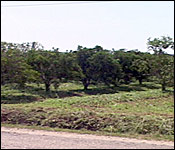
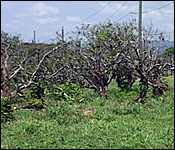
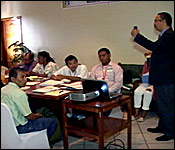
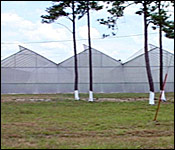
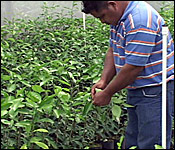 There are about 40 - 45,000 commercial acres of land dedicated to citrus in Belize. 80% is set aside for oranges and 20% is for grapefruit. It is a mammoth business generating over 100 million dollars in annual earnings. Although it is a big money business, there are many threats to the survival of the citrus trees such as citrus leprosies and the tristeza virus. But there is another disease that the Citrus Growers Association has been monitoring since it was detected in Belize in 2009- and that's the Huanglongbing disease better known as HLB or citrus greening. Today the CGA hosted a technical training for 10 Caribbean countries about the effective ways to control this disease. We traveled to Dangriga today to find out how deadly the disease is and what is being done to contain it.
There are about 40 - 45,000 commercial acres of land dedicated to citrus in Belize. 80% is set aside for oranges and 20% is for grapefruit. It is a mammoth business generating over 100 million dollars in annual earnings. Although it is a big money business, there are many threats to the survival of the citrus trees such as citrus leprosies and the tristeza virus. But there is another disease that the Citrus Growers Association has been monitoring since it was detected in Belize in 2009- and that's the Huanglongbing disease better known as HLB or citrus greening. Today the CGA hosted a technical training for 10 Caribbean countries about the effective ways to control this disease. We traveled to Dangriga today to find out how deadly the disease is and what is being done to contain it.
Courtney Weatherburne reporting
This green expanse of land is the scene for miles as you travel along the Southern highway. The landscape that unfolds before you tells of the flourishing citrus industry in Belize. But this beauty and richness is being threatened by an insidious force.
And these professionals have organized a workshop to try and address it.
Veronica Manzanero Majil, Research and Extension Director, CRIE
 "We are providing technical training on the management of Huanglongbing or HLB disease. We are organizing this training for participants from 10 Caribbean countries to make them more acquainted and teach them the basic techniques of management of HLB."
"We are providing technical training on the management of Huanglongbing or HLB disease. We are organizing this training for participants from 10 Caribbean countries to make them more acquainted and teach them the basic techniques of management of HLB."
Courtney Weatherburne
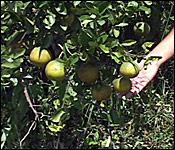
 "I am walking about 12 acres of citrus groves in the Fresh Water area. There are about 1,200 trees and from this angle, they may look lush and healthy, but if you look closely, that's not the case. That's because almost 100% of this citrus groove is infected with the HLB disease."
"I am walking about 12 acres of citrus groves in the Fresh Water area. There are about 1,200 trees and from this angle, they may look lush and healthy, but if you look closely, that's not the case. That's because almost 100% of this citrus groove is infected with the HLB disease."
Henry Anderson, CEO, Citrus Growers Association
"It's a bacteria called the silas that in in the tree. It's transmitted by a vector called the Asian citrus psyllid. That's the one in Belize. And what happens is that when the psyllid goes to a plant that has HLB, the psyllid picks up the bacteria and then it carries it to the other trees. Now the psyllids are attracted to the new shooting. When you have the new leaves coming out in the tree, that's what they like. They go on there and they lay their eggs - the nymphs, they called them. You have 4 stages of nymphs. Those nymphs feed on the plants and also transmit the HLB to it or get the HLB from it and transmit it around."
Veronica Manzanero Majil
"Well Huanglongbing/HLB, some people would know it as citrus greening, is a very devastating disease and it is transmitted by a vector that is also present in Belize since 2005 and it has no cure. No cure and there is no citrus variety that is tolerant to the disease. The disease cannot be eradicated, it can only be managed."
And a part of that management strategy is building a plant nursery.
 Thomas Tate, Nursery Manager, Plant World
Thomas Tate, Nursery Manager, Plant World
"All citrus nursery must be produced under screen and that means that you do a structure that is screened totally. BAHA does inspections. You have to certify those structures and then you grow the plants in there and they (BAHA) also do inspections as you go along to certify the trees that they are free of diseases."
There are 400,000 plants housed at this nursery in Red Bank. And in order to protect them against any infection, a double entrance door with a disinfectant mat was installed for workers and visitors to enter these structures.
In here is where the bud grafting takes place with the Valencia Orange and the sour orange among other variations.
The plants are taken care of for less than a year and when they have reached optimal size they are transplanted out on the field and the rigorous HLB management system continues.
This disease has already destroyed countless acres of citrus groves and now many of the trees that once stood tall and plush have been reduced to dry barks with dry empty limbs protruding.
But there is still hope for citrus in Belize.
 Henry Anderson, CEO, Citrus Growers Association
Henry Anderson, CEO, Citrus Growers Association
"The citrus industry grosses over US$100 million per year. As I said in there, before petroleum, it was the largest major export earner and is set to go back there again. When you look at our economy having a fixed peg 2-1, which means that central bank has to hold an amount of US dollars. If you were tomorrow to wave a wand and not have a citrus industry, this country would be in serious trouble. By putting all of these fore prongs together where you control the psyllid to disrupt the vector and the transmission, you take out the infected plants that are un-economical - the ones that are not making any money, you plant clean plants and then when you put in these clean plants, remember you are controlling the psyllids and you are putting a good nutrition program in place, that not only feeds the tree, but also take care of greasy spot and then you can be in the business for a long time."
Veronica Manzanero Majil
"We are now on survival mode, but we have to think futuristic, that while our trees are infected, the key in the fore prong approach to HLB management is: 1) reducing that vector population. Why? Because we have to ensure that when these new planting come from these protective screen houses and go out into the field, the population is low enough that it will give these new plants a fighting chance against HLB."
There is also another aspect of the management strategy that targets abandoned groves and back yards. These green houses are used as Tamarixia Rearing facilities. Tamarixia is a parasitoid or wasp that attacks the psyllid which transfers the HLB virus.



